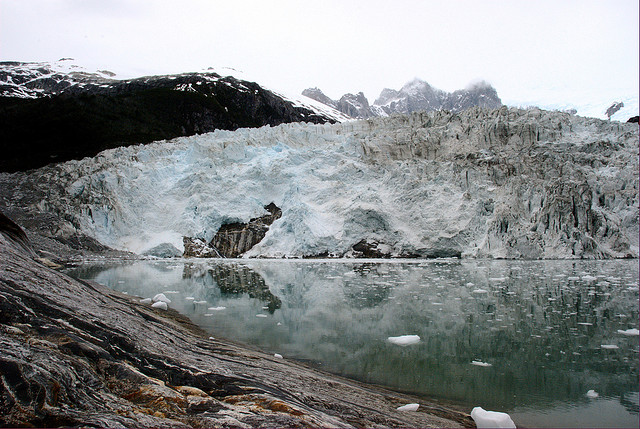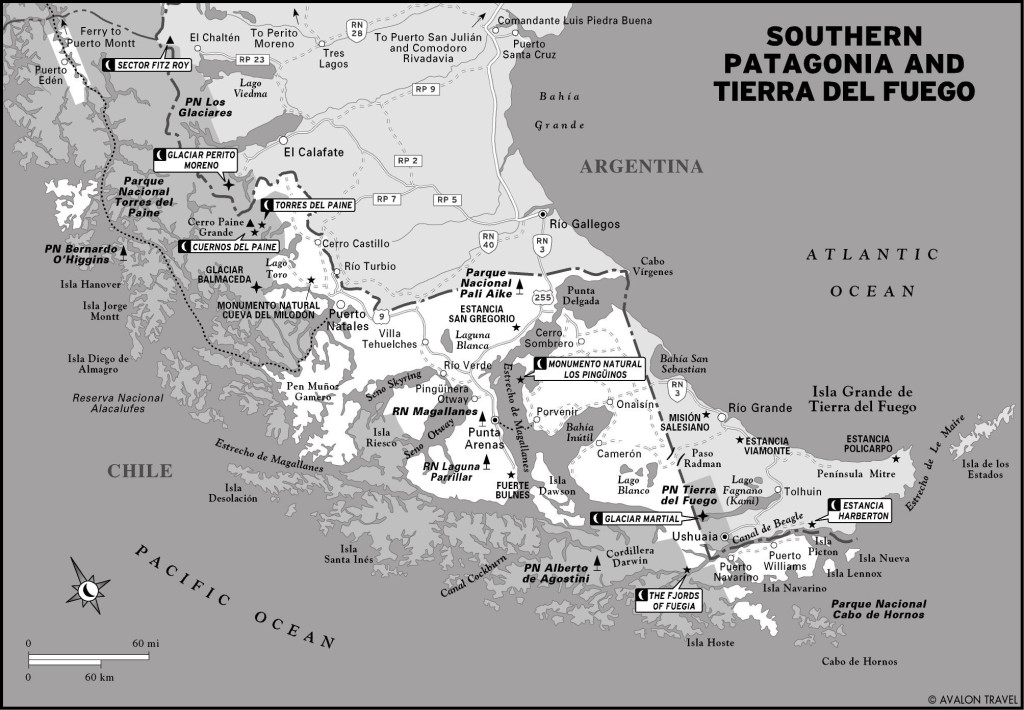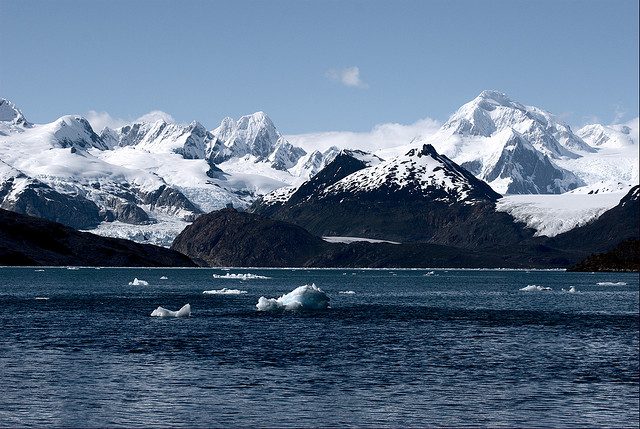Short of Antarctica itself, some of the Southern Hemisphere’s most awesome scenery occurs in the Beagle Channel and southern Tierra del Fuego. And as usual, Charles Darwin left one of the most vivid descriptions of the channel named for the vessel on which he sailed:
The lofty mountains on the north side compose the granitic axis, or backbone of the country, and boldly rise to a height of between three and four thousand feet, with one peak above six thousand feet. They are covered by a wide mantle of perpetual snow, and numerous cascades pour their waters, through the woods, into the narrow channel below. In many parts, magnificent glaciers extend from the mountain side to the water’s edge. It is scarcely possible to imagine anything more beautiful than the beryl-like blue of these glaciers, and especially as contrasted with the dead white of the upper expanse of the snow. The fragments which had fallen from the glacier into the water, were floating away, and the channel with the icebergs presented, for the space of a mile, a miniature likeness of the Polar Sea.

Pía glacier in the western Beagle Channel. Photo © Luis Alejandro Bernal Romero, licensed Creative Commons Attribution.
Unlike the Navimag ferry from Puerto Montt to Puerto Natales, these are cruises in the traditional sense. The passengers are waited on hand and foot, and they’re not cheap.Even today, few visitors see Tierra del Fuego’s splendid fjords—little changed since Darwin described them in 1833, except for the receding glaciers. Many of those who do see the fjords do so onboard weeklong excursions from Punta Arenas to the Argentine port of Ushuaia and back on the Chilean vessel Via Australis or the larger and more luxurious Stella Australis (every cabin on the Stella has a huge picture window, and it has additional lounges with audiovisual gear, and even a top-deck gym with running tracks and stationary bicycles).Unlike the Navimag ferry from Puerto Montt to Puerto Natales, these are cruises in the traditional sense. The passengers are waited on hand and foot, and they’re not cheap. Yet for the foreseeable future, this remains the only way to see the area short of sailing your own yacht or chartering someone else’s, and for that reason it’s worth consideration even for those with limited finances.
One common alternative is to do either leg of the voyage separately—either five days and four nights from Punta Arenas to Ushuaia, or four days and three nights from Ushuaia to Punta Arenas. The boats sometimes undertake variants, and there’s usually some duplication. Both legs, for instance, usually visit Cape Horn and the western Beagle Channel’s Glaciar Pía. Routes can also vary depending on weather conditions in this notoriously capricious climate.
After an evening departure from Punta Arenas’s Muelle Prat, the vessel usually crosses the Strait of Magellan to enter the Seno del Almirantazgo (Admiralty Sound), a westward maritime extension of the freshwater Lago Fagnano trough. Passengers usually go ashore at Bahía Ainsworth, near the Glaciar Marinelli, where there’s a short hiking trail through what was once forest until feral beavers dammed the area into a series of ponds. The most interesting sight for most visitors is a small elephant seal colony. Farther west, at Isla Tucker, there’s a Magellanic penguin colony (observed from an inflatable Zodiac), and it’s also possible to see the rare striated caracara, Phalcoboenus australis.

Southern Patagonia and Tierra del Fuego
After a night’s sailing that includes Canal Cockburn, where open ocean swells can rock the boat at least briefly, the vessel turns into the calmer Canal Ocasión and eventually enters the Beagle Channel’s north arm, sailing past the so-called Avenida de los Glaciares, a series of glaciers named for various European countries. After entering Fiordo Pía (Pía Fjord), where dozens of waterfalls cascade down sheer metamorphic slopes, passengers normally disembark at Glaciar Pía, where a short hike leads to an overlook as angular seracs collapse off the glacier’s face and into the sea.
Darwin, again, described the dangers of travel in a land that sea kayakers are just beginning to explore:
The boats being hauled on shore at our dinner hour, we were admiring from the distance of half a mile a perpendicular cliff of ice, and were wishing that some more fragments would fall. At last, down came a mass with a roaring noise, and immediately we saw the smooth outline of a wave traveling toward us. The men ran down as quickly as they could to the boats; for the chance of their being dashed to pieces was evident.

Ainsworth bay and the Marinelli glacier. Photo © Luis Alejandro Bernal Romero, licensed Creative Commons Attribution.
After traveling through the night, the ship anchors at Cabo de Hornos (Cape Horn), and, wind permitting (less than 45 knots), passengers disembark in a rocky cove to hike to the stylized iron albatross silhouette that symbolizes sailors who lost their lives “rounding the Horn.” At the lighthouse, tended by a Chilean naval officer with his family, there is now a small gift shop.
Again, if weather permits, the captain can choose to round the Horn before proceeding north to Bahía Wulaia, on Isla Navarino’s western shore. Here passengers visit the site of an early mission where, in a notorious incident, the Yámana massacred all but one of the Anglicans and their crew. There is then the option of a short but steep hike with panoramic views of the bay, or an easier shoreline walk to see birdlife, including Magellanic oystercatchers.
Before continuing to Argentina, the vessel stops at Puerto Navarino, at the western end of Isla Navarino, for immigration formalities (the crew shuttles the documents ashore and back by Zodiac). Proceeding to Ushuaia, passengers spend the night aboard; those returning to Punta Arenas have the day free in Ushuaia before returning to the ship, while new passengers check their bags downtown before boarding in late afternoon.
After reentering Chile at Puerto Navarino, the ship sails south to Cape Horn again for an early disembarkation and stops again at Wulaia as well. Returning to the Beagle Channel, it veers westward through the north arm, again passing the Avenida de los Glaciares. It re-enters Canal Cockburn, rounding Península Brecknock to the Fiordo Chico (Little Fjord), where passengers board Zodiacs for an easy shoreline walk to the receding Glaciar Águila. On the final morning, the boat sails north to Isla Magdalena before returning to Punta Arenas.
Well-organized without being regimented, the cruise is informal in terms of dress and behavior. At the start, passengers sign up for meal tables; places are fixed for the duration, though some small groups join their tables. In general, passengers are grouped by language, though they often place together people who speak English as a second language. The staff themselves can handle Spanish, English, German, French, and some other languages.
After introduction of the captain and crew, and an obligatory safety drill, there’s a welcome drink and a brief folklore show (in Punta Arenas) or tango demonstration (in Ushuaia). Smoking is prohibited everywhere except the exterior decks. The package includes bar consumption.
The cabins themselves are spacious, with either a double bed or twin beds, built-in reading lights, closet with hangers and shelves (with a small lock box for valuables), and private bath with excellent hot shower. Some also have a fold-down bunk for children or a third person. The food is abundant and often excellent, though breakfasts can be a little monotonous. The wine is superb, and the service exceptional. Vegetarian menus are available on request.
For those who tire of the landscape or when weather is bad, onboard activities include karaoke, slide lectures on history and flora and fauna, engine-room tours, knot-tying demonstrations, and documentary films on topics such British explorer Ernest Shackleton and local wildlife. The farewell dinner is a fairly gala affair, followed by champagne on the top deck.
Punta Arenas is the homeport for fjord-bound cruises. Check-in takes place at Turismo Comapa (Magallanes 990, tel. 061/2200200) 1pm-5pm, while boarding takes place 5pm-6pm at the entrance to Muelle Prat. Some passengers begin or end the trip in Argentine Tierra del Fuego, where check-in takes place at Comapa’s Ushuaia office (San Martín 245, tel. 02901/430727, 9am-4pm); boarding takes place 5pm-6pm at the Muelle Comercial (at the foot of 25 de Mayo).
Often this popular cruise runs full September-April. In December and January, days are so long that it’s possible to enjoy the landscape until after 11pm, and there’s sufficient light to read by at 4am.
Make reservations through Cruceros Australis (Av. Bosque Norte 0440, 11th Fl., Las Condes, Santiago, tel. 02/24423110), which also has representatives in Buenos Aires (tel. 011/5199- 6697) and in the United States (toll-free 877/678-3772). Per-person rates for four days and three nights start at US$1,189 in low season and go up to US$3,338 in high season. For five days and four nights, the comparable rates are US$1,440 in low season to US$4,040 in high season.
Excerpted from the Fourth Edition of Moon Patagonia.